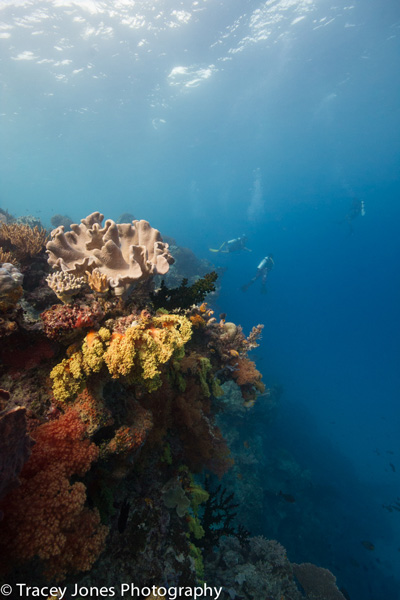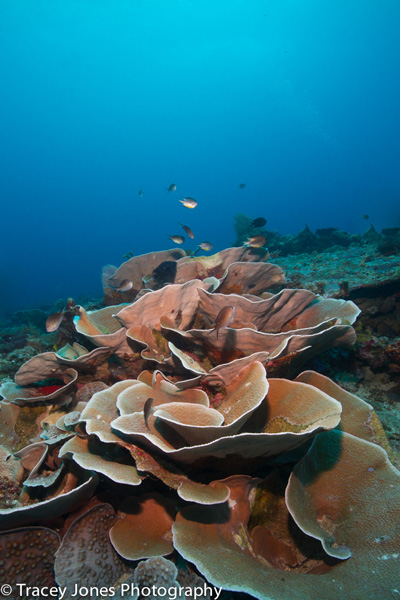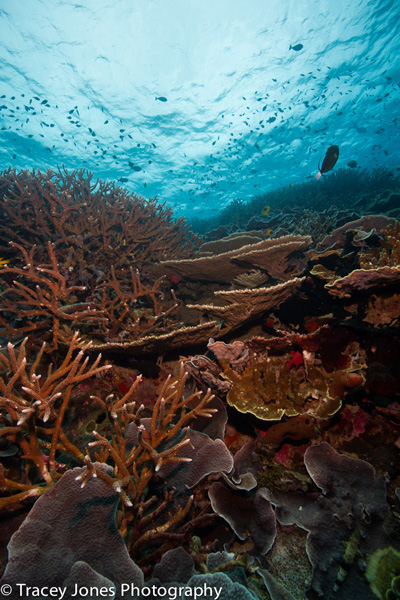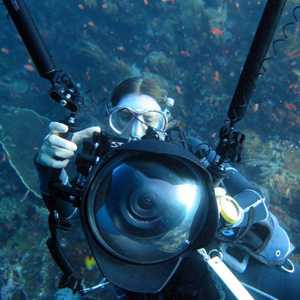3 Reasons to Shoot Vertical
Whether above or below the water, many new photographers only take pictures in a horizontal orientation. This can be limiting because composition is one of the key ingredients needed to make a great photo, and orientation is the first thing to consider when composing a shot.
In this article I will explain three reasons why a portrait composition can sometimes be better with underwater photography.
Adding a Sense of Depth
The vertical presentation is brilliant for showing how deep a reef is. Drop offs and walls are a good example of this; the top of the image will be bright with the sunlight from the surface, but as the viewer’s eye follows the line of the wall down, the image will get darker because less light filters through the water. The darkness gives the viewer a perception of endlessness as they are not able to see the bottom.
 Sunlight from the surface lands on the top of the reef illuminating the coral in the center of the image, whilst the wall drops off getting darker towards the bottom. ISO 800, f/10, 1/125
Sunlight from the surface lands on the top of the reef illuminating the coral in the center of the image, whilst the wall drops off getting darker towards the bottom. ISO 800, f/10, 1/125
 The crop emphasizes the shape and separates the jacks from the smaller surgeon fish in the foreground. ISO 250, f/7.1, 1/125
The crop emphasizes the shape and separates the jacks from the smaller surgeon fish in the foreground. ISO 250, f/7.1, 1/125
Vertical Lines
Lines can be found in most pictures; they are used to lead the viewer’s eye through the photo, often creating a sense of distance. Underwater there are many subjects that can create vertical lines: corals, wrecks, piers, walls, eels, fish, bubbles and even sunbeams. If you constrain these lines within a horizontal frame, they will appear shorter and the subject may seem squashed. Turning the camera sideways will allow for the lines to stand out and take the viewer on a journey through the picture.


Photo left: These three corals are placed one behind the other creating a line drawing you into image. ISO 400, f/6.3, 1/125
Photo right: The break in staghorn coral creates a line leading up towards the surface. ISO 400, f/9, 1/125
Fish Portraits
As the name suggests, portraits look best in a portrait presentation. There are many marine creatures which naturally fit a portrait frame: eels, snakes and fish schooling in tornadoes to name a few. However, most fish are a natural landscape shape, so photographers often shoot them that way. Cropping just the head and shoulders of the fish in a portrait frame can create a closer and more revealing image of the fish.

This image was originally in a landscape orientation but after experimenting I cropped it like this to emphasis the line of the snake’s body coming out of the black. ISO 2000, f/8, 1/125
Shooting in portrait orientation provides many different options for creating stunning compositions that will make you stand out from the crowd. These are just three examples of where portrait images work well, but almost any underwater scene can be shot in a vertical frame. Taking the time to stop and think about a composition can inspire a new approach. Just go out and experiment, take your time and think about every shot, but don’t forget to have fun.
About the Author
 Tracey Jones has been working as an underwater photographer for the past four years in South East Asia. She currently works for Bali Reef Divers (Amed, Bali) where she photographs students and teaches photography courses. For more examples of her work please visit:
Tracey Jones has been working as an underwater photographer for the past four years in South East Asia. She currently works for Bali Reef Divers (Amed, Bali) where she photographs students and teaches photography courses. For more examples of her work please visit:
www.traceyjonesphotography.com | www.facebook.com/traceyjonesphotography
RECOMMENDED ARTICLES
SUPPORT THE UNDERWATER PHOTOGRAPHY GUIDE:
The Best Service & Prices on u/w Photo Gear
 Visit Bluewater Photo & Video for all your underwater photography and video gear. Click, or call the team at (310) 633-5052 for expert advice!
Visit Bluewater Photo & Video for all your underwater photography and video gear. Click, or call the team at (310) 633-5052 for expert advice!
The Best Pricing, Service & Expert Advice to Book your Dive Trips
 Bluewater Travel is your full-service scuba travel agency. Let our expert advisers plan and book your next dive vacation. Run by divers, for divers.
Bluewater Travel is your full-service scuba travel agency. Let our expert advisers plan and book your next dive vacation. Run by divers, for divers.





























